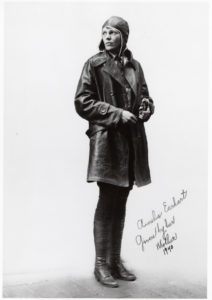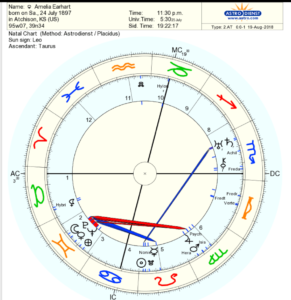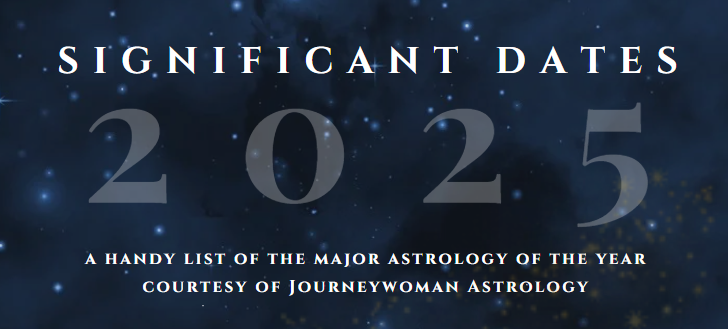Astrology is the poetry of astronomy. –Steven Forrest
Astrology has many different branches and techniques. One I’m particularly fascinated by is the study of the smaller planetary bodies—the asteroids and stars.
The stars are often called “fixed” because they don’t move much—just a minute or so per year. The asteroids often have erratic orbits. As astronomers’ knowledge of planetary bodies increases, astrology has taken note and begun to make use of them.
When we start to take them into account, it’s hard to avoid hyperbole: it’s in the use of these minor bodies that astrology becomes utterly fascinating, if not astonishing. If you’re on the fence about astrology, their use might make you a believer.
Astronomers name stars and asteroids quite poetically: frequently, they refer to mythological, spiritual, and religious concepts or figures. They can also refer to prominent or historical figures (Soros, Kennedy) or places (Paris, Washingtonia). Some are named for other well-known folks: there’s a Georgeclooney and Freddiemercury up there, too.
These asteroids and stars are often uncannily prominent in event and personal charts. Alex Miller, who specializes in asteroid analysis, pays attention to Washingtonia in the charts of politicians, for example. In the natal chart of the natural leader and likely future member of the House of Representatives, Alexandria Ocasio-Cortez, Washingtonia falls on her natal Saturn-Uranus conjunction.
Many times, they’re simply personal names—but these can have an uncanny relationship to individual charts too. Ocasio-Cortez, interestingly, already has an asteroid named after her, Miller notes—a product of her high school interest in science. It is conjunct Nike (the Greek goddess of victory) and the asteroid Alexandra. “This does seem to be a destiny written in the stars,” Miller exclaims, suggesting she may be speaker of the House, even president, someday.
In my own chart, the asteroid named for my sister falls in my natal fourth house, where it is conjunct the asteroid most closely matched to my own first name. That conjunction of our names directly opposes our family surname. Meanwhile, my mother’s name is conjunct my natal Ceres, directly opposite my beloved stepfather’s name. It’s trivia in a way, sure, but you can’t make this stuff up—and similar “coincidences” appear in every chart. As an experiment, it’s worth checking out where your present or past partner’s and family members’ names fall in your own natal chart. (If you don’t know how, I can do this for you in a reading—just provide the names you’re most interested in checking when scheduling.)
Working with stars and asteroids
Demetra George has long been a pioneer in studying these smaller cosmic bodies. This video is fun: in two case studies, George explores the connections between Diana, Prince Charles, and Camilla Parker Bowles (whose names are prominent in each another’s charts), and between the Clintons, Monica, and Bill’s other dalliances. As George describes, Princess Diana had Paris and Karma conjunct on her ascendant at the time of her death.
It’s in the goddesses and other feminine figures that I find the highest use for these bodies, particularly for women. Western, and particularly American, culture is still nearly devoid of examples and role models for female strength, self-direction, and self-definition. Seeing where our natal chart has one, if not many, goddesses prominently placed (often on an angle or conjunct a planet) can bring inspiration for our own lives and relationships.
For men, George suggests, when the goddess asteroids are prominent, they can indicate qualities they’ll project onto the women in their life, or, in “integrated” men, qualities they themselves express.

Earhart: Flying high
As an example, let’s have a look at the chart of Amelia Earhart (a childhood hero of mine). The first woman to fly solo over the United States and the second person—after Charles Lindbergh—to fly solo over the Pacific Ocean, her confidence, courage, and sheer joie de vivre were remarkable in her time, if not still in ours.
A few elements immediately stand out in her natal chart. First, the Mars-Jupiter conjunction in her 5th house of creativity, expression, joy: this is a woman who wrote a book entitled For the Fun of It, and with this placement adventure would be a defining element of her life. Mars conjunct Jupiter shows fortitude, daring, and agility, often with a pronounced focus on physicality—it is often the aspect of the warrior, or indeed the airplane pilot. For women, this conjunction could certainly show up in the chart of a trailblazer. (Angelina Jolie, who has arguably redefined the female action hero, has a Jupiter-Mars-Moon conjunction on her midheaven in Aries.) As a child, Earhart kept notebooks of newspaper clippings about “women in predominantly male-oriented fields, including film direction and production, law, advertising, management, and mechanical engineering.” Meanwhile, this conjunction squares Earhart’s stellium in her 2nd, amplifying her determination (Pluto) to achieve her dreams (Neptune) and enhancing her appeal to an adoring public (Venus-Neptune).
Isis, Hera, Athene
Now to the smaller bodies: here’s where things get even more interesting. The asteroid Hera is conjunct Jupiter-Mars (at 3 degrees), in a royal trinity of strength. Hera, the Greek counterpart to the Roman Juno, can represent equality in relationships, particularly for women. My teacher, Dawn Bogrodi, found Juno to be especially prominent in the charts of social activists; Earhart indeed did social work in Boston before beginning aviation, and as an ardent feminist, advocated for women throughout her career, even creating her own line of clothing (her glamorous style a forerunner to activewear). In addition, we see Hylonome conjunct Earhart’s MC—another asteroid signifying equal relationships. Meanwhile, the adventurer Odysseus conjoins Amelia’s 7th house cusp, reflecting their shared death-defying travels.
Yet the asteroid Isis is an even closer conjunction to Amelia’s Mars-Jupiter, at 2 degrees, and the most heavily aspected of any I’ve examined. Isis was the Egyptian goddess of the sky, and yet another who was an equal to her mate Osiris. Recurring themes like this underscore their importance. In inscribed hymns, Isis is called “the Lady of Heaven.” Fitting, then, that Earhart would be the first woman to conquer the skies.
Meanwhile, asteroid Diana squares her midheaven (by 1 degree), exactly trines Venus, trines Pluto and Neptune at 3 degrees, and is conjunct her Vertex, highlighting its importance to her relationships. The astrologer Jessica Adams suggests Diana is where women “run free”—where we must have our independence, no matter the hell or high water. Diana, the Roman goddess of the hunt, was the ultimate independent woman: she didn’t want to marry or have children, so her father Jupiter granted her freedom to do as she wished. (Adams does not use asteroids or stars named for Greek or other cultural deities, inexplicably, which is where I would differ; the work of George and others, such as Alex Miller, has shown their validity in endless contexts.)
The asteroid Athene—Diana’s Greek counterpart—is even more prominent for Earhart, conjunct her Venus at 3 degrees. Of her flight across the Atlantic, she said it proved men and women equal in “jobs requiring intelligence, coordination, speed, coolness, and willpower.” Athene is also exact on Earhart’s natal Neptune and makes a quincunx to both her North Node and Chiron, which may be associated with wounding—a “tense” placement. Her strength, ability to see clearly, and even her experiences at sea would ultimately, and tragically, be at odds with her fate. Karma also trines her MC (the midheaven is often what we will be remembered for, suggesting she would be well known in posterity), while her nodes (an indication of destiny) square Chiron. Chiron itself squares Asbolus, an asteroid of luck.
Fred and Palmer
Of Earhart’s marriage to George Palmer Putnam, she said it was a “partnership” with “dual control.” The asteroid Putnam is close to her descendant, while Palmaria, more suggestively, conjuncts her Vertex and aspects her stellium of Moon, Mercury, Venus, and Pluto.
Yet it appears her relationship with her navigator, Fred Noonan, could have been even more important, according to the asteroids—at least to her fate. Various forms of his name conjunct her Vertex, descendant, and Sun.

Neptune’s revenge
Earhart’s attempt to be the first woman to fly around the world, along with her subsequent disappearance, made her a legend. Earhart’s very Neptunian disappearance at sea has captivated researchers and the public for nearly a century. But Neptune’s lower expression, which can dissolve or mislead, is particularly prominent in her ill-fated flight.
To start with, Earhart’s namesake asteroid, Amelia, trines her natal MC, but it is also conjunct the asteroid Karma, and squares natal Neptune. On July 2, 1937—the date of she and navigator Noonan’s last radio contact—progressed Neptune was within one degree of her progressed Ascendant, while her progressed Ascendant was conjunct natal Neptune. Meanwhile, Jupiter had just transited her natal midheaven, and her progressed Sun was on natal Mars-Jupiter. She certainly had the guts and ambition, but perhaps it was the planet of the sea that ultimately clouded her judgment.
For the last 7,000 mile stretch of their 29,000 mile journey, she and Noonan had set themselves a nearly impossible mark: their refueling point was meant to be Howland Island, a tiny island a mile and a half wide. “Howland is such a small spot in the Pacific that every aid to locating it must be available,” Earhart said. Yet Noonan navigated primarily by the stars—handicapping his skill when a storm came up, as it did that day.
A researcher recently reanalyzed bones found on Nikumaroro Island, about 400 miles from Howland. Other suggestive remains were found on the island. It seems likely Noonan’s hampered navigation in the storm put them off course—Neptune again—and they were forced to land where they could. Recently released distress calls also suggest they probably landed alive. The evidence persuasively suggests the remains were Earhart’s.
Before the flight, she wrote:
“Please know I am quite aware of the hazards. I want to do it because I want to do it. Women must try to do things as men have tried. When they fail, their failure must be but a challenge to others.”
Her courage, glamour, and vivacity continue to be an example for women (and possibly men as well). With a chart and character like hers, one imagines she was happier to have gone trying.

This Post Has One Comment
Pingback: On goddess asteroids -